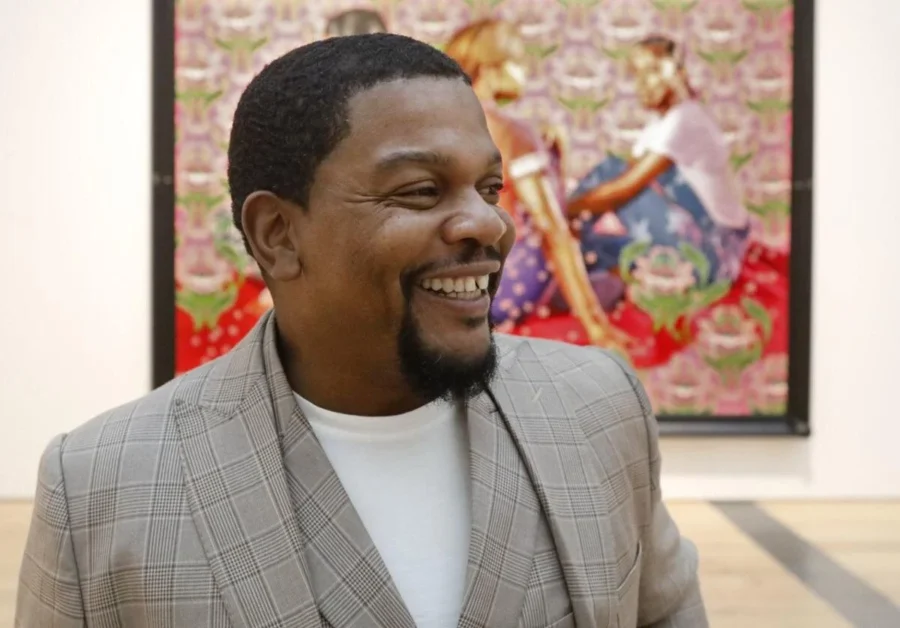Kehinde Wiley’s work has redefined contemporary art for over two decades by challenging the Eurocentric perspective that historically dominated Western painting. By re-contextualizing Old Master paintings with contemporary Black and Brown subjects, he has altered how the art world perceives power, identity, and representation in art history. His art is highly relevant in an era concerned with social justice, decolonization, and equitable representation, acting as a catalyst for cultural discourse. His influence extends beyond his paintings, affecting institutional practices, market dynamics, and the very definition of artistic achievement. A pivotal moment in his career was the unveiling of his official portrait of President Barack Obama in 2018, which brought his distinctive style to a global audience and cemented his status as a transformative artist.
Historical and Contextual Background
Born in Los Angeles in 1977, Kehinde Wiley’s mother nurtured his early artistic talent by enrolling him in after-school art classes. His passion for portraiture developed at a young age, and he attended an art exchange program in Russia at age 11. He went on to earn a BFA from the San Francisco Art Institute in 1999 and an MFA from Yale University in 2001.
A crucial moment that helped shape his signature style occurred during a residency at the Studio Museum in Harlem in 2001. He saw a police mugshot, and this ordinary object made him realize the contrast between the dehumanizing way Black men were often portrayed in society and the majestic representations found in classical painting. This led to his “street casting” method, where he invites individuals he meets on the street to model for his portraits. These models often choose poses from art history books, directly engaging with the very art canon Wiley is reinterpreting.
Wiley’s artistic philosophy involves a radical re-appropriation of Western art history, drawing from Renaissance, Baroque, French Rococo, Venetian, and Dutch Golden Age portraiture. He subverts traditional ideas of power and prestige by placing contemporary Black and Brown individuals, often in streetwear, into these opulent, historically white settings. His work explores themes of identity, representation, and the portrayal of Black and Brown masculinity and physicality. His breakthrough series, “Passing/Posing” (2001–04), replaced historical figures with young Black men in hip-hop clothing. He then expanded his street casting globally with “The World Stage” (2007–ongoing), which included models from cities like Mumbai, Dakar, and Rio de Janeiro, broadening the discussion on global Black identity. In 2012, his series “An Economy of Grace” was his first to feature female subjects, celebrating Black female power.
Current Landscape
Kehinde Wiley’s recent exhibitions show an expansion of his thematic interests beyond identity-focused portraiture to address broader global concerns. For example, the traveling exhibition “An Archaeology of Silence” (2022-2025) builds on his 2008 “DOWN” series and features monumental paintings and sculptures of fallen Black figures. This exhibition directly responds to systemic violence against Black bodies, such as the murder of George Floyd. Critics have praised its “lyrical and poetic” elements and its powerful way of confronting the “silence surrounding systemic violence”. Another exhibition, “A Maze of Power” (2023-2025), features portraits of African heads of state, exploring the depiction of power and leadership in a style associated with European royalty. The exhibition “Havana” (2023) focused on Cuban circus performers and street dancers, using the “carnivalesque” as a metaphor for freedom and defiance in Afro-Caribbean culture.
A notable thematic shift is seen in “Colorful Realm” (2023), which was inspired by Japanese Edo period nature paintings. These more minimalist works explore humanity’s relationship with nature and ecological disasters, a departure from his earlier dense floral backgrounds. His upcoming exhibition, “Flourish” (2025), will engage with the colonial legacy of Museum Van Loon in Amsterdam by centering individuals who were historically excluded from such spaces.
This thematic evolution, seen in exhibitions like “An Archaeology of Silence” and “Colorful Realm,” shows an artist who is responding to contemporary global crises. While his early work focused on re-contextualizing Old Master portraits with Black figures to explore identity, his newer work tackles systemic issues like police violence and ecological disasters. This is a deepening of his critical engagement with the world, not just an aesthetic shift.
Wiley’s work is in the permanent collections of more than 40 public institutions globally, including the National Portrait Gallery and the Brooklyn Museum. He is represented by major galleries worldwide, which highlights his prominent position in the contemporary art world. The market for his work is “insatiable”. His studio produces about 20 paintings a year, which typically sell for six- to seven-figure sums. His appeal comes from his meticulous technique and his sensitive portrayal of Black bodies, which challenges troubling societal treatments. The fact that his art, which critiques Western art history, is embraced by major institutions and the market shows a complex dynamic where the art establishment is willing to embrace a critical voice as a way of self-reflection and modernization. This suggests that institutions and collectors see value in the social commentary and the disruption he brings to the art canon.
A significant development in Wiley’s career is his founding of Black Rock Senegal in 2019, an artist-in-residence program in Dakar. The program’s mission is to “incite change in the global discourse about what Africa means today”. This initiative aims to support new artistic creation and shift the art world’s center of gravity toward Africa by providing a platform for international artists to engage with Senegalese art and traditions. This is a deliberate effort to decentralize the art world and challenge Western dominance. By creating this new cultural infrastructure, Wiley is actively addressing the historical underrepresentation of African artists and narratives.
Critical Perspectives
Wiley’s use of Old Master compositions is central to his critique of the Western art canon. By placing Black and Brown individuals in positions of power, he reverses the traditional “gaze” that often marginalized or exoticized them. This “alchemical transmutation” of European pictorial language forces viewers to confront who has historically held symbolic power in art.
Paradoxically, his art, which is meant to be subversive, has become integrated into the mainstream art establishment. It is “rabidly collected,” sells for high prices, and is exhibited in major museums globally. This raises the question of whether the art’s radical edge is dulled by its mainstream acceptance or if its widespread visibility amplifies its message to a broader audience.
Wiley’s commercial success also brings up ethical and aesthetic questions. His studio system, which uses assistants to create detailed backgrounds, allows for high output but sometimes leads to debate about authorship. Wiley himself has acknowledged the complex dynamic between his critical intent and the market reality, as his art is a “high-priced luxury good” that appeals to an elite class whose aesthetics are about exclusion, not inclusion.
A controversy arose from his 2012 painting “Judith and Holofernes,” which depicted a Black woman holding the severed head of a white woman. The painting was seen by some as a “symbolic threat to white supremacy,” and it highlighted the double standards applied to art that depicts violence when racial roles are reversed.
More recently, Wiley has faced multiple accusations of sexual assault and misconduct, including a lawsuit filed in 2025. He has denied these allegations. In response, three U.S. museums have postponed or canceled his planned solo exhibitions. This has sparked a debate within the art world, with organizations like the National Coalition Against Censorship (NCAC) criticizing the museums’ decisions. The NCAC argued that museums should not act as “enforcers of moral orthodoxy” and that canceling shows harms audiences and risks reducing the “complexity and quantity of art eligible for exhibition”. This ongoing controversy forces a reckoning with the relationship between an artist’s personal conduct and the reception of their art.
Speculative or Forward-Looking Analysis
Wiley’s recent shift toward landscape painting and ecological concerns in “Colorful Realm” suggests a broadening of his artistic focus beyond the human figure. This could lead to a deeper exploration of humanity’s relationship with nature in the context of climate change. His engagement with global power dynamics through portraits of African heads of state also shows a move toward a more globally informed re-imagination of art history. He is not just correcting historical omissions in a single tradition but is actively building a new, global art history that draws from diverse cultural lineages.
The success of Black Rock Senegal signals Wiley’s commitment to creating new art world centers outside of traditional Western hubs. This initiative could become a major force for cultural diplomacy and artistic exchange, re-centering African narratives and talent. Wiley’s role as an institution-builder, rather than just an artist, positions him to actively shape the infrastructure and discourse of the global art ecosystem. By creating new platforms, he is influencing the future trajectory of the art world’s power dynamics and geographic centers.
Kehinde Wiley’s legacy will be defined by his transformative impact on representation in art history, having already “opened doors for many” emerging artists. His influence will likely continue to inspire a more diverse and inclusive art world. However, his legacy will also be linked to the ethical debates surrounding artist conduct. The ongoing legal challenges and the art world’s response will shape how future generations view the relationship between an artist’s personal life and their art. The discourse will likely mature, moving toward more nuanced approaches that acknowledge complex realities while upholding artistic freedom.
Kehinde Wiley is a singular force in contemporary art, constantly challenging the boundaries of representation. From his re-contextualization of Old Master portraits to his engagement with global narratives and social justice, he has left a significant mark on 21st-century art. His art shows the transformative power of art to reflect, critique, and reshape societal perceptions of power and identity. Through his bold aesthetic and initiatives like Black Rock Senegal, he has not only asserted the presence of Black and Brown bodies in the art canon but has also worked to decentralize the global art world. As the art world continues to address its historical biases and ethical challenges, Wiley’s ongoing evolution and the conversations his art provokes will remain central to the discourse.









